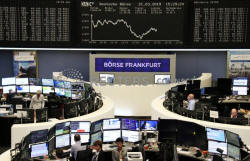Recession obsession keeps the mood subdued
 Send a link to a friend
Send a link to a friend
 [March 26, 2019]
By Marc Jones [March 26, 2019]
By Marc Jones
LONDON (Reuters) - Calm returned to global
markets on Tuesday as a steadier day for Europe and Asia's bourses and a
tick higher in benchmark bond yields helped ease nerves after a jarring
few days dominated by recession worries.
European shares were just about winning the battle to avoid a fifth day
of losses, the euro was holding its ground after three days of falls and
Turkey's lira seemed to have stepped off its latest rollercoaster ride.
The bond markets remained the main focus though: 10-year German
government bond yields remained below zero and key sections of the U.S.
yield curve remained inverted -- where short-term borrow costs are
higher than longer-term ones.
"The world is looking to fade the risk aversion caused by the inversion
of the (U.S.) yield curve," said Societe Generale strategist Kit Juckes,
adding that it was anyway difficult to position for a hypothetical
recessions.
Overnight, MSCI's broadest index of Asia-Pacific shares rebounded 0.2
percent after losing 1.4 percent in the previous session, though there
were some eye-catching moves within that.
Japan's Nikkei jumped 2.1 percent after recording its biggest drop since
late December on Monday [.T], India jumped over 1 percent whereas
China's blue-chip CSI300 index dropped more than 1 percent as trade war
worries remained. [.SS]

Wall Street was expected to start higher later although it was the bond
market that was the principle focus there too. [.N]
Investors have been spooked by sharp falls in U.S. bond yields and an
inversion of the U.S. Treasury yield curve, which is widely seen as an
indicator of an economic recession.
The 10-year U.S. Treasury yield edged up to 2.442 percent, having shed 5
basis points on Monday and a whopping 17.5 basis points since the
Federal Reserve last week ditched projections for raising rates this
year.
"The U.S. yield curve continues to invert," said Michael Every, Hong
Kong-based senior Asia-Pacific strategist at Rabobank. "This is not a
healthy sign, as bond-market watchers should know and equity-market
obsessives should rapidly learn."
FACTORING IN A RATE CUT
The Treasury Department will sell $113 billion in coupon-bearing supply
this week, including $40 billion in two-year notes on Tuesday, $41
billion in five-year notes on Wednesday and $32 billion in seven-year
notes on Thursday.
[to top of second column] |

The German share price index DAX graph is pictured at the stock
exchange in Frankfurt, Germany, March 21, 2019. REUTERS/Staff

Investors will also be watching Fed policymakers scheduled to speak on Tuesday.
U.S. economic growth could be "pretty weak" in the first quarter but will likely
be much closer to 2-2.5 percent for the rest of the year. However, a central
bank pause is the responsible thing to do, Fed Bank of Boston president and CEO
Eric Rosengren said at a conference in Hong Kong.
Fed funds rate futures are now fully factoring in a rate cut later this year,
with about an 80 percent chance of a move priced in by September.
In the currency market, the fall in U.S. yields undermined the dollar's yield
attraction.
The euro stood firm at $1.1305, having gained a tad on Monday after Germany's
IFO Institute said its business climate index rose to 99.6, beating a consensus
forecast of 98.5 and ending six consecutive months of decline.
The dollar was 0.4 percent higher versus the yen at 110.14 yen, having hit a
1-1/2-month low of 109.70 on Monday, while British pound was barely budged at
$1.3180 after lawmakers voted late on Monday to wrest further control of the
Brexit process from Prime Minister Theresa May..
"We expect EUR/USD to stabilize around the current level of 1.13 and see a
limited downside for the rest of week," said currency strategists at ING.
Among commodities, oil prices hovered below their recent four-month peaks, as
the prospect of tighter U.S. crude supply was offset by concerns about a
slowdown in global economic growth.
U.S. crude futures traded at $59.55 per barrel, up three-quarters of a percent
on the day but below Thursday's $60.39, which was its highest level since
mid-November.
Brent futures were up 0.7 percent at $67.73 while safe-have gold was down a
third of a percent at $1,317.60 having hit a one-month high of $1,324.60 on
Monday.
(Additional reporting by Tom Finn in London)
[© 2019 Thomson Reuters. All rights
reserved.] Copyright 2019 Reuters. All rights reserved. This material may not be published,
broadcast, rewritten or redistributed.
Thompson Reuters is solely responsible for this content. |